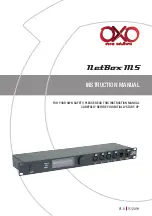
Operation
900-0161-01-01 Rev B
29
Advanced Battery Technologies
Advanced battery technologies such as lithium-ion and sodium-sulfur may require very different
settings from the inverter’s defaults or the three-stage cycle in general. The
Charging Steps
section describes the individual selections and behavior. All charger settings are adjustable for
different priorities. For example, the Float voltage could be set higher than the Absorption voltage,
or a step could be completely skipped.
Charging Steps
The following items describe the operation and intended use for each individual charging step
as shown in the graphs. Note that some charging cycles may not follow this exact sequence.
These include cycles which were previously interrupted, and also customized charging. Each
step describes how to defeat or customize the step if specialized charging is required.
See page 31 for a description of multiple cycles when the charger is restarted after completion.
This page also describes multiple cycles when the charger is restarted after being interrupted.
For multiple inverters:
The charging of stacked inverters is synchronized and is governed by the master inverter. The
voltage settings of all other inverters are ignored. Slave inverters use the master settings.
No Charging
If the inverter is not charging, several conditions may apply:
The unit is not connected to a qualified AC source. If a generator is present, it may not be running.
The unit is connected to an AC source but the charger has been turned off.
Bulk Stage
This is the first stage in the three-stage charge cycle. It is a constant-current stage which drives
the battery voltage up. This stage typically leaves the batteries at 75% to 90% of their capacity,
depending on the battery type, the exact charger setting, and other conditions.
Voltage Used:
Absorb Voltage
setting. The default setting is 57.6 Vdc.
The initial DC current may be as high as the charger’s maximum current, depending on
conditions. The current will begin at a high level, but will tend to drop slightly as the voltage
rises. This is not a reduction in charging. It can be viewed as a wattage “tradeoff”. The actual
kilowatts used by the charger are shown in the
Inverter
menu. The reading is usually
consistent at this stage. (See page 43.)
To skip this step:
Setting
Absorb Voltage
equal to
Float Voltage
causes the charger to
proceed through the normal three-stage cycle, but at a single voltage. Setting
Absorb Time
to 0 causes the charger to skip both the Bulk and Absorption stages and proceed directly to the
constant-current Refloat stage. This may not be desired if the intent is to include the Bulk stage
but skip Absorption.
Absorption Stage
This is the second stage of charging. It is a constant-voltage stage. Current varies as needed
to maintain the voltage, but will typically decrease to a very low number over time. This “tops off
the tank”, leaving the batteries at essentially 100% of capacity.
Voltage Used:
Absorb Voltage
setting. This setting is also used by
Offset
when in this stage.
(See page 36.) For the three-stage cycle to proceed normally, this setting should be kept higher
than the
Float Voltage
and
Re-Bulk Voltage
settings.
Содержание OutBack Power GS8048A
Страница 1: ...Radian Series Inverter Charger GS4048A GS8048A Operator s Manual ...
Страница 6: ...Table of Contents 6 900 0161 01 01 Rev B THIS PAGE INTENTIONALLY LEFT BLANK ...
Страница 20: ...Operation 20 900 0161 01 01 Rev B NOTES ...
Страница 56: ...Troubleshooting 56 900 0161 01 01 Rev B NOTES ...
Страница 67: ...Specifications 900 0161 01 01 Rev B 67 NOTES ...
















































